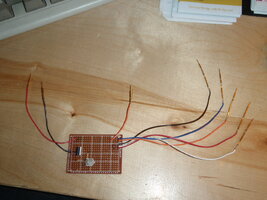OK, I learned a few things recently that may help the next guy so I'll post them up here.
First I learned that if your car has an aftermarket Dorman climate control module and you have a Tech 2 clone you will not be able to command the blend door actuators to move. It is even debateable whether the calibration procedure that the Tech 2 clone commands is executed correctly by the Dorman module. Luckily there is a calibration method with the Dormans that does not require the Tech 2.
Since I couldn't command the HVAC actuators with the Tech 2 clone I own, I built a small test jig. If you remove the climate control module in any modern GM vehicle and look into the connector in the dash you will be looking at direct connection points to the actuators. You can hook up and command all four actuators and test them for operation before you tear the dash apart to change them. Looking at the picture the RED and BLK on the left go into plug to recieve +12V and ground. The five wires on the right represent the five connections to any one actuator. RED= +12V for the motor. WHT = the command voltage, BLK = ground for the motor and circuitry, ORG = the feedback signal, and BLUE = +5V reference voltage.
The potentiometer on the board will vary the voltage on the white command wire. Keep the voltage around 2.5V and the motor does not move. turn the pot to raise the voltage up over about 3V and the motor turns one way. Turn the pot the other way to reduce the voltage below about 2V and the motor turns in the opposite direction. A volt meter connected from the short orange wire to ground will show you a varying voltage between 0V and 5V depending on where the motor is in it's arc.
It's a pretty easy test jig to build if you can solder, you need a 10k pot, two 1k resistors, a 7805 voltage regulator and some pins that will fit the connector in the vehicle. By moving the pins around the connector you can easily test all four actuators in a few minutes. You can also check actuators out of the vehicle, on a workbench, if you have a 12V power source of some kind.
I hope what I've learned helps someone.
JayArr
First I learned that if your car has an aftermarket Dorman climate control module and you have a Tech 2 clone you will not be able to command the blend door actuators to move. It is even debateable whether the calibration procedure that the Tech 2 clone commands is executed correctly by the Dorman module. Luckily there is a calibration method with the Dormans that does not require the Tech 2.
Since I couldn't command the HVAC actuators with the Tech 2 clone I own, I built a small test jig. If you remove the climate control module in any modern GM vehicle and look into the connector in the dash you will be looking at direct connection points to the actuators. You can hook up and command all four actuators and test them for operation before you tear the dash apart to change them. Looking at the picture the RED and BLK on the left go into plug to recieve +12V and ground. The five wires on the right represent the five connections to any one actuator. RED= +12V for the motor. WHT = the command voltage, BLK = ground for the motor and circuitry, ORG = the feedback signal, and BLUE = +5V reference voltage.
The potentiometer on the board will vary the voltage on the white command wire. Keep the voltage around 2.5V and the motor does not move. turn the pot to raise the voltage up over about 3V and the motor turns one way. Turn the pot the other way to reduce the voltage below about 2V and the motor turns in the opposite direction. A volt meter connected from the short orange wire to ground will show you a varying voltage between 0V and 5V depending on where the motor is in it's arc.
It's a pretty easy test jig to build if you can solder, you need a 10k pot, two 1k resistors, a 7805 voltage regulator and some pins that will fit the connector in the vehicle. By moving the pins around the connector you can easily test all four actuators in a few minutes. You can also check actuators out of the vehicle, on a workbench, if you have a 12V power source of some kind.
I hope what I've learned helps someone.
JayArr

